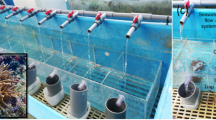Abstract
Gemmules of the freshwater sponge, Eunapius fragilis (Leidy), survived exposure to 30 ppt natural sea water at 20 °C for up to 27 days and to 37 ppt Instant Ocean sea water for up to at least 9 days. This high salinity tolerance may have made possible the dispersal of the sponge on the hulls of ocean-going ships that frequented freshwater ports. The gemmules also survived 9-day exposures to 5% NaCl, 20% NaCl and some artificial sea waters containing only a few of the major ions. All of these solutions inhibited germination of the gemmules during the period of exposure, and treatment with 30 ppt natural sea water, 37 ppt Instant Ocean sea water, 20% NaCl and a solution containing Na+, Cl− and SO sup2−inf4 had a persisting inhibitory effect on gemmule germination after the gemmules were returned to pond water at 20 °C. Many of the gemmules that did not germinate under favorable conditions following treatment could be stimulated to germinate after they were chilled at 4 °C for 4 or more months. Such gemmule inhibition mimics natural diapause which also is broken by exposure to low temperature.
Similar content being viewed by others
References
Annandale, N., 1915. Fauna of the Chilka Lake: sponges. Mem. Indian Mus. Calcutta 5: 23–54.
Barbeau, M. A., H. M. Reiswig & L. C. Rath, 1989. Hatching of freshwater sponge gemmules after low temperature exposure: Ephydatia mulleri (Porifera: Spongillidae). J. Therm. Biol. 14: 225–231.
Benfey, T. J. & H. M. Reiswig, 1982. Temperature, pH, and photoperiod effects upon gemmule hatching in the freshwater sponge Ephydatia mulleri. J. exp. Zool. 221: 13–21.
Boutselis, N. J., P. E. Fell & S. H. Loomis, 1990. Low temperature tolerance of the gemmules of Eunapius fragilis. J. exp. Zool. 225: 125–129.
Carlton, J. T., 1989. Man's role in changing the face of the ocean: biological invasions and implications for conservations of near-shore environments. Conser. Biol. 3: 265–273.
Carlton, J. T. & J. A. Scanlon, 1985. Progression and dispersal of an introduced alga: Codium fragile spp. tomentosoides (Chlorophyta) on the Atlantic Coast of North America. Bot. Mar. 28: 155–165.
Cavanaugh, G. M., 1956. Formulae and Methods IV Marine Biological Laboratory, Woods Hole, Mass. 61 pp.
Degani, G., N. Silanikove & A. Shkolnik, 1984. Adaptation of green toad (Bufo viridis) to terrestrial life by urea accumulation. Comp. Biochem. Physiol. 77A: 585–587.
Fell, P. E., 1975. Salinity tolerance and desiccation resistance of the gemmules of the brackish water sponge Haliclona loosanoffi. J. exp. Zool. 194: 409–412.
Fell, P. E., 1987. Influences of temperature and desiccation on the breaking of diapause in the gemmules of Eunapius fragilis (Leidy). Int. J. Invertebr. Reprod. Dev. 11: 305–315.
Fell, P. E., 1990. Environmental factors affecting dormancy in the freshwater sponge Eunapius fragilis (Leidy). Int. J. Invertebr. Reprod. Dev. 18: 213–219.
Fell, P. E. & L. J. Bazer, 1990. Survival of the gemmules of Anheteromeyenia ryderi (Potts) following aerial exposure during winter in New England. Hydrobiologia 190: 241–246.
Fell, P. E. & E. D. Levasseur, 1991. Cold hardiness of the green gemmules of Spongilla lacustris L. (Porifera: Spongillidae). Hydrobiologia 218: 107–112.
Francis, J. C., M. A. Poirrier & R. A. LaBiche, 1982. Effects of calcium and salinity on the growth rate of Ephydatia fluviatilis (Porifera: Spongillidae). Hydrobiologia 89: 225–229.
Harrison, F. W., 1982. Developmental biology of freshwater sponges. Developmental Biology of Freshwater Invertebrates. F. W. Harrison & R. R. Cowden (eds), Alan R. Liss, Inc., New York: 1–67.
Okland, K. A. & J. Okland, 1989. The amphiatlantic freshwater sponge Anheteromeyenia ryderi (Porifera: Spongillidae): taxonomic-geographic implications of records from Norway. Hydrobiologia 171: 177–188.
Poirrier, M. A., 1969. Louisiana fresh-water sponges: taxonomy, ecology and distribution. Ph.D. thesis, Louisiana State University. University Microfilms, Inc., Ann Arbor, Michigan.
Pulunin, N., 1960. Introduction to Plant Geography. McGraw-Hill Book Co., Inc., New York: 640 pp.
Rasmont, R., 1954. La diapause chez les Spongillides. Bull. Acad. Roy. Belgium, Sci. 40: 288–304.
Simpson, T. L. & P. E. Fell, 1974. Dormancy among the Porifera: gemmule formation and germination in fresh-water and marine sponges. Trans. Am. Microscop Soc. 93: 544–577.
Simpson, T. L., C. A. Vaccaro & R. I. Sha'afi, 1973. The role of intragemmular osmotic pressure in cell division and hatching of gemmules of the fresh-water sponge Spongilla lacustris (Proifera). Z. Morph. Tiere 76: 339–357.
Tendal, O. S., 1967. On the freshwater sponges of Denmark. Videns. Meddel. Dansk. Naturhist. Foren. 130: 173–178.
Waterston, A. R., 1981. Present knowledge of non-marine fauna of the outer Hebrides. Proc. R. Soc. Edinburgh 79B: 215–321.
Author information
Authors and Affiliations
Rights and permissions
About this article
Cite this article
Fell, P.E. Salinity tolerance of the gemmules of Eunapius fragilis (Leidy) and the inhibition of germination by various salts. Hydrobiologia 242, 33–39 (1992). https://doi.org/10.1007/BF00017641
Received:
Revised:
Accepted:
Issue Date:
DOI: https://doi.org/10.1007/BF00017641




